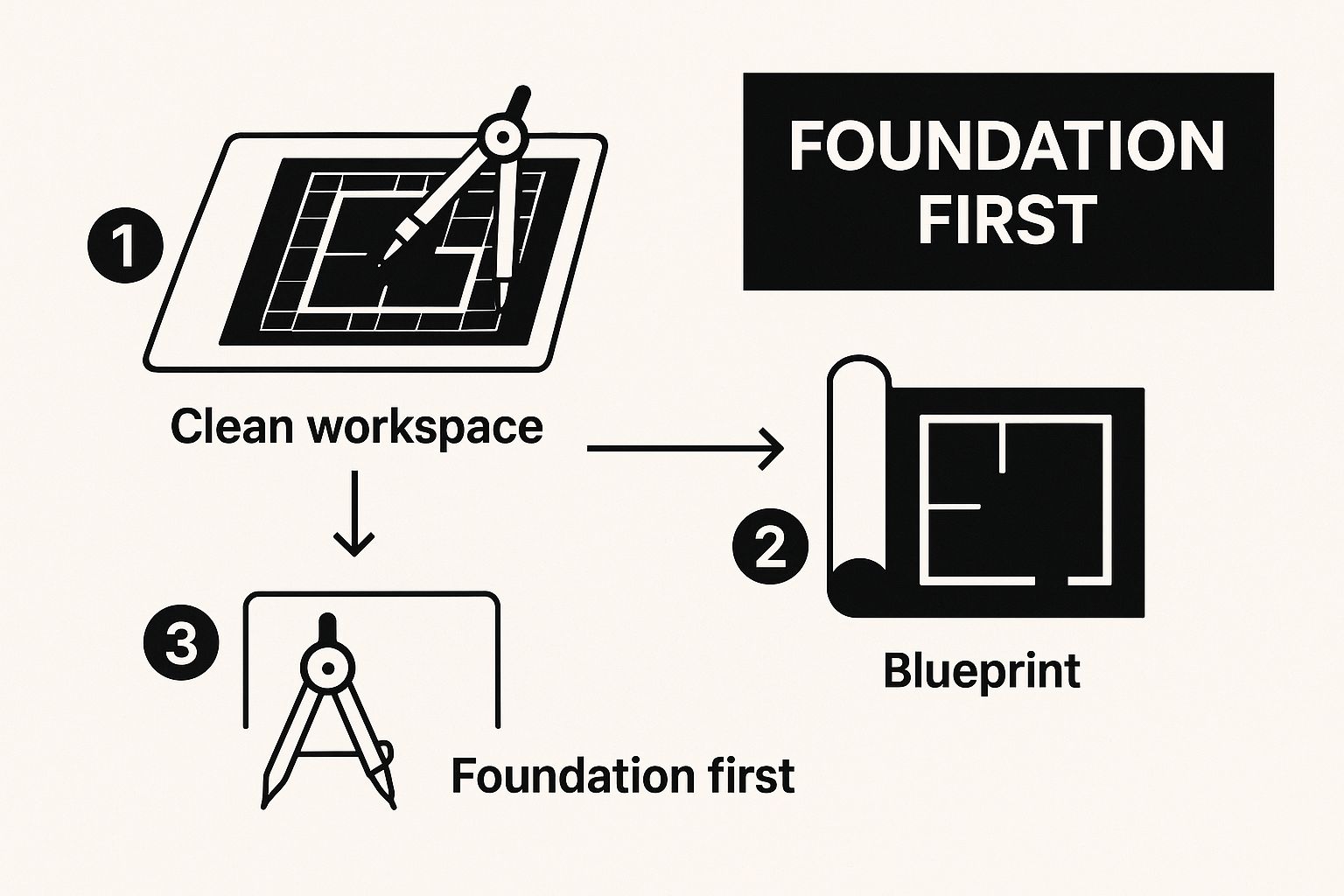A solid SaaS content strategy is your plan for creating and distributing content that actually pulls in the right kind of audience—the kind that eventually buys your product. It's so much more than just starting a blog. It’s a deliberate system that connects what your product does with the problems your ideal customers are desperate to solve.
Building Your Foundation for SaaS Content Success
Before you even think about writing a single blog post, you have to lay the groundwork. So many SaaS companies get this wrong. They jump straight into creating content without a clear plan, burn through resources, and see almost no impact.
A winning strategy starts by tying every single piece of content back to a measurable business goal. This ensures you're not just attracting random visitors but actively guiding qualified prospects toward your solution.
Define Your Business Goals
Everything has to start with "why." What's the business objective here? "More traffic" isn't a goal; it's a vanity metric.
Real content strategies are pinned to specific business outcomes, like hitting $10 million in annual recurring revenue (ARR). From there, you work backward. To hit that number, you need to understand who your ideal customer is and what keeps them up at night. This is the only way to create content that moves them through your sales funnel.
A common mistake is treating content as a separate department from sales and product. For a SaaS business, content is the bridge between your product's features and your customer's most urgent problems. It has to be built to support revenue goals from day one.
Go Beyond Generic Personas
Forget about those vague personas like "Marketing Mary." If you want to create content that actually lands, you need a deeply defined Ideal Customer Profile (ICP). This isn't about demographics; it's about understanding the specific "jobs" your customers are trying to get done when they hire your software.
- Pinpoint Their Challenges: What are their biggest headaches? Are they drowning in inefficient workflows, fighting with data silos, or getting crushed by high operational costs?
- Identify Their Desired Outcomes: What does a "win" look like for them? Is it a 15% reduction in manual data entry? A faster time-to-market? Maybe it's just better team collaboration so they can all go home on time.
- Understand Their World: Where do they hang out online? What industry publications do they actually read? What specific words do they use to describe their problems? Get into their heads.
This infographic shows just how critical this foundational stage is. It’s the first real step in building a content plan that works.

As you can see, aligning your business goals with a deep customer understanding has to happen before you create anything. A detailed ICP lets you map every content idea back to a real pain point, guaranteeing you produce assets that actively solve problems.
To get more tactical on this, you can learn more about building a content marketing strategy framework. This approach makes sure your content doesn't just attract eyeballs—it guides the right prospects toward choosing your solution.
Mapping Customer Pain Points to Content Solutions
Once you have a crystal-clear ICP, you can start connecting their problems to specific content solutions. This table is a simple but powerful framework for turning customer pain into content that builds trust and drives action at every stage of the funnel.
This isn't just about creating content; it's about engineering a customer journey. Each piece you create should address a specific need at a specific moment, moving them one step closer to becoming a successful, long-term customer.
Here’s the rewritten section, designed to sound completely human-written and match the expert, natural tone of the provided examples.
Designing Your SaaS Content Creation Engine
Great SaaS content doesn’t just happen. It's the result of a well-oiled machine, not random acts of content creation. Building this engine is what separates the brands that consistently grow from those that just make noise. It’s about building a structured, repeatable process where every single piece serves a purpose.
A smart way to start is with the Topic Cluster model. Think of your core product features or solutions as the center of their own little solar systems. For each one, you create a massive, comprehensive "pillar page" that covers the topic from every angle. This becomes your central hub of knowledge.
From there, you build out a web of more specific articles—the "cluster content"—that dive deep into one particular aspect of the main topic.
Let's say your pillar page is on "Email Outreach Automation." Your cluster content might look something like this:
- "How to Write Cold Emails That Actually Get Replies"
- "The Top 5 Email Personalization Techniques for 2024"
- "Comparing Email Outreach Tools for Small Agencies"
- "Measuring the ROI of Your Outreach Campaigns"
Each of these articles links back to that main pillar page. This structure does more than just organize your content; it screams to search engines that you have deep, authoritative expertise on the subject, which is exactly what you need to rank for those high-value keywords.

Beyond the Blog Post
While blog posts are your foundation, a modern SaaS content strategy has to be more diverse. Not everyone wants to read a 2,000-word article. Some of your best prospects would rather watch a video or listen to a podcast. The trick is knowing which format to use and when.
Webinars, for instance, are perfect for those middle-of-the-funnel prospects who are already evaluating solutions. A solid webinar can turn attendees into demo requests at a rate a blog post could only dream of.
Video tutorials are your secret weapon for retention. Short, punchy videos that solve one specific problem can slash your support ticket volume and stop churn in its tracks.
And don't forget data-rich reports or original research. This is how you build backlinks and get noticed by the media. Dropping a study that shows 73% of companies in your niche are struggling with a specific challenge instantly positions you as an industry leader.
Establishing a Production Workflow
To keep this engine running without constant breakdowns, you need a crystal-clear production workflow, managed through a content calendar. And I don't just mean a spreadsheet with dates on it. This should be your command center for everything from planning to publishing.
Your content calendar should be a source of truth, not a source of stress. It needs to track every stage—from the initial idea and keyword research to drafting, review, design, and promotion. That kind of visibility is what prevents bottlenecks and keeps your team from burning out.
A typical workflow might be broken down like this:
- Ideation & Prioritization: Pulling ideas from keyword research and, more importantly, from actual customer feedback.
- Brief Creation: Building a detailed outline that covers the target keyword, audience, key points to hit, and internal links to include.
- Drafting: Handing it off to an in-house writer or a freelancer you trust.
- Review & Editing: A crucial step for checking accuracy, tone, and making sure the SEO is on point.
- Design & Staging: Getting graphics made and loading the final piece into your CMS.
- Publication & Promotion: Pushing it live and getting it in front of people across all your channels.
This isn’t bureaucracy for its own sake. A structured approach like this turns content creation from a chaotic scramble into a predictable system that pumps out high-impact assets to move your business forward.
Choosing Content Formats That Actually Convert
In B2B SaaS, not all content is created equal. Some formats are great for building top-of-funnel awareness, but others are built to close deals. A smart SaaS content strategy doesn't just make noise; it focuses on the formats that have a direct line to revenue.
Too many marketers get stuck on the content hamster wheel, churning out endless blog posts and hoping something sticks. Instead, you need to be surgical. Deploy specific content types that answer your customers' most urgent questions at the exact moment they’re ready to buy.
Prioritize High-Intent, Trust-Building Assets
When a prospect is seriously considering your solution, they don't need another "10 tips" article. They need proof. This is where your case studies and thought leadership transform from marketing fluff into your most powerful sales enablement tools.
Think about it: over 70% of B2B marketers point to case studies as the most effective format for turning leads into customers. Why? Because they offer tangible evidence that your product solves a real, painful problem for a company just like theirs. On top of that, 55% of B2B buyers say that thought leadership significantly impacts their purchasing decisions. Deep expertise builds the trust you need to close the deal. You can find more of these SaaS content stats at RevenueZen.
To make your case studies hit hard, stick to this simple formula:
- The Problem: Get specific. Define the exact, quantifiable pain the customer was dealing with before they found you.
- The Solution: Show, don't just tell. Explain precisely how your software was implemented to fix that pain point.
- The Results: This is the money shot. Showcase the bottom-line impact with hard numbers, like a "30% increase in productivity" or "$50,000 saved in operational costs."
This isn’t just storytelling. It’s providing a blueprint for success that a prospect can see themselves in.
Establish Authority with Proprietary Insights
Beyond customer stories, creating your own data reports or forward-thinking analyses is what separates the commentators from the true industry leaders. This is real thought leadership. Instead of just reacting to trends, you're the one creating the data that fuels the entire conversation.
Don’t just report on the news in your industry—be the source of it. Commission a survey, analyze your own platform's usage data (anonymously, of course), and publish a unique report. This is how you build backlinks, get press, and become the go-to authority.
Sure, this kind of content isn't quick to produce. But its long-term value is massive. It attracts high-quality links from other industry players, gets shared by decision-makers, and builds a level of credibility that a generic blog post simply can't touch.
For any SaaS business serious about growth, investing in these high-conversion formats isn't just a good idea—it's non-negotiable.
Mastering SaaS Content Distribution and Promotion
You’ve poured everything into creating a brilliant piece of content. But hitting "publish" is just the starting line. Getting it in front of the right people at the right time is how you actually win the race.
A powerful content strategy for SaaS hinges on a multi-channel distribution plan that doesn't just push content out, but pulls high-intent users in. Think of it as an ecosystem, not a checklist. Every piece you create is an asset that can be amplified across dozens of channels, each playing a specific role in bringing prospects closer. This is where your hard work really starts to pay off.

Fueling Your Strategy with SEO and Repurposing
The most sustainable way to attract qualified users is through search. Simple as that. You’re not interrupting their day; you’re showing up with an answer to a question they’re already asking.
When you target keywords with clear buying intent, you attract users who are actively looking for a solution like yours, not just browsing. This approach is fundamental if you want to increase website traffic organically and build a reliable engine for new leads.
But great SEO isn't just about the initial blog post. The real magic is in content repurposing. One pillar post can be systematically broken down into dozens of micro-assets, maximizing your reach without multiplying your workload.
- LinkedIn Articles & Carousels: Pull key insights from your blog and turn them into a sharp thought leadership article or a visually engaging carousel that grabs the attention of decision-makers.
- Email Newsletter Series: Don't just send a link. Break down a comprehensive guide into a multi-part email series that nurtures your subscribers over time.
- Video Scripts & Webinars: Your detailed post is already a perfect script. Use it as the foundation for a short tutorial video or the outline for an in-depth webinar.
- Partner Networks: Snip out relevant sections of your content and share them with complementary businesses to include in their newsletters or resource hubs.
This approach ensures you’re present on the platforms where your ideal customers spend their time, reinforcing your message in the formats they prefer.
Building a Cohesive Multi-Channel Presence
A truly effective distribution strategy gets different channels working together. For instance, use a platform like LinkedIn not just to drop links, but to spark actual conversations with key players in your industry. Engage with their posts, offer genuine insights, and build relationships that go beyond a single click.
It’s also critical to think about how people find information now. Search is becoming more conversational, which means optimizing for AI-driven platforms is no longer optional. Making sure your content serves as a primary source for AI chatbots is key. You can dig deeper with this helpful guide to Answer Engine Optimization that breaks down the concept.
Your distribution strategy should create a flywheel effect. SEO brings in new users, email nurtures them with repurposed content, and social media engages them in a continuous conversation. Each channel feeds the others, amplifying your reach and building sustainable momentum.
Using Content to Reduce Churn and Boost Retention
https://www.youtube.com/embed/45k4pQ6nwSc
You’ve landed a new customer. Great. But your SaaS content strategy doesn't end there. In fact, this is where the real work—and the real profit—begins.
Acquisition is always going to be expensive. True, sustainable growth comes from keeping the customers you already have. Content is your secret weapon for creating a stellar post-purchase experience that keeps users engaged, successful, and fiercely loyal.
Empower New Users With Killer Onboarding Content
Those first few weeks with your product are make-or-break. If new users feel lost or don't get that initial "aha!" moment quickly, the odds they'll churn go way up. Your job is to guide them to that first win as fast as possible.
This is about more than a generic welcome email. You need a dedicated onboarding flow that actually empowers them.
- Bite-Sized Video Tutorials: Nobody wants to sit through a 45-minute demo. Create a library of short, 2-3 minute videos that show users exactly how to complete key tasks. Each one should solve a single, specific problem.
- In-App Guides: Use tooltips and guided walkthroughs to introduce features in context, right when a user is exploring your platform. It feels helpful, not overwhelming.
- "First Steps" Checklists: Give them a clear, simple checklist of what to do in their first week. This cuts through the noise and shows them exactly how to get value from day one.
When you're proactive like this, you turn a new user's initial uncertainty into confidence. You're not just selling software; you're setting them up for a long-term win.
So many SaaS companies make the mistake of assuming customers will just figure things out. Don't. Your retention-focused content should remove every bit of friction and make it incredibly easy for users to succeed. That's how you stop them from ever looking for an alternative.
Build a World-Class Knowledge Base
When a customer hits a snag, what's their first move? It’s not emailing support—it’s Googling for an answer. A comprehensive, easy-to-search knowledge base is absolutely non-negotiable.
Think of it as your single source of truth. It should be packed with best-practice guides, troubleshooting articles, and deep dives into your most powerful features. Organize it logically and, most importantly, make it searchable.
A great knowledge base doesn't just improve the customer experience; it takes a massive load off your support team. The goal here is to turn brand-new customers into power users who feel like they’ve mastered your tool.
Deliver Ongoing Value to Drive Loyalty
Retention isn't a one-time event; it's about delivering continuous value long after the sale. Your content needs to grow with your customers, helping them get more out of your product over time.
This is where you can get creative. Think about targeted email sequences that introduce advanced features to your veteran users. Or run webinars that showcase clever new use cases they haven't thought of. It shows you’re invested in their success, not just their subscription fee.
Focusing on the customer experience is everything. The average SaaS customer churn rate was 5.9% in 2022, but a superior experience can completely change that math. In fact, a staggering 85% of customers are willing to pay more for SaaS products that provide exceptional support and a smooth user experience.
One of the most overlooked parts of this experience is mobile accessibility. Projections show that 72.6% of internet users will access the web only on their phones by 2025. If your help docs and tutorials are a nightmare to read on a small screen, you're creating friction.
You can discover more insights about SaaS statistics on GrowthMarketingPro.com. By building an amazing, accessible customer experience, you’re not just reducing churn—you’re building a stable business fueled by advocates.
Content Types for Each Stage of the Customer Lifecycle
Thinking about the customer journey helps you map the right content to the right moment. It's not just about what you create, but when you deliver it. This table breaks down which formats tend to work best at each stage, from grabbing a prospect's attention to keeping a long-term customer happy.
Matching your content to the customer's immediate needs is one of the smartest ways to make them feel understood and supported. This isn't just a content strategy; it's a customer success strategy.
Measuring the Real ROI of Your SaaS Content
How do you prove your content is actually moving the needle? It’s time to ditch the vanity metrics like page views and traffic spikes. A winning SaaS content strategy needs a measurement framework that speaks the language of your CEO and board.
This means drawing a straight line from your content to real business outcomes. The goal is to build a system that not only justifies your budget but also delivers the insights you need to get better every single day. Without it, you're just guessing in the dark.
Moving Beyond Vanity Metrics
First things first: shift your focus from top-of-funnel noise to bottom-of-funnel impact. Sure, traffic is a nice leading indicator, but it doesn't pay the bills. The real questions are about how your content is pushing prospects toward a conversion.
Your measurement should revolve around a few core metrics:
- Marketing Qualified Leads (MQLs): How many leads from things like ebook downloads or webinar sign-ups are actually good enough to send to sales?
- Trial Sign-ups: Which articles or guides are consistently convincing visitors to start a free trial?
- Demo Requests: What content is bringing in high-intent prospects who are ready to see the product in action?
Tracking these KPIs tells you which content pieces aren't just attracting an audience, but attracting the right audience—the one that’s seriously considering a purchase.
Calculating Content-Influenced Revenue
To truly get the executive team on your side, you have to connect content directly to cash. This is where Content-Influenced ARR becomes your best friend. This metric tracks any new annual recurring revenue from customers who touched your content at any point before they converted.
It's an incredibly powerful way to show the direct financial impact of your work. For example, you might discover that customers who read three or more blog posts before signing up have a 20% higher lifetime value. That kind of data makes a rock-solid case for investing more in your content machine.
Proving ROI isn't just about defending your budget; it's about making smarter decisions. When you know which content drives revenue, you know where to double down. It transforms your content plan from a list of topics into a strategic growth lever for the entire company.
To really get a full picture of your content's performance, it's also a good idea to consistently evaluate the quality of your content with structured feedback.
Why Engagement Still Matters
While revenue is the ultimate prize, don't throw engagement metrics out the window just yet. They offer critical clues about whether your content is actually connecting with your audience. Metrics like scroll depth and time on page can tell you if people are truly reading and absorbing what you've created.
Think of them as diagnostic tools. If a high-traffic blog post has a pathetically low time on page, that's a red flag. The content isn't hitting the mark. This kind of insight lets you go back, refine your strategy, and fix what's broken—turning underperforming assets into pieces that hold attention and drive action.
You can find a deeper dive into these and other important content marketing metrics to build out a comprehensive dashboard that tells the whole story.
Frequently Asked Questions About SaaS Content
It's natural to have questions when you're mapping out a SaaS content strategy. Here are a few of the most common ones I hear from founders and marketers, along with some straight-shooting answers.
How Long Does It Take to See Results
Everyone wants to know this one. While you might get lucky with a few early wins, a real SaaS content strategy is a long game. Realistically, you’re looking at 6-9 months before you see a meaningful, consistent impact on organic traffic, quality leads, and keyword rankings.
The first few months are all about laying the groundwork—digging into research, building out your foundational pillar content, and slowly earning authority. The secret ingredient is relentless consistency. The SaaS companies that stick to a schedule and publish genuinely helpful content are the ones who see their results start to compound over time.
Building a content engine is like planting a tree. You won't see much at first, but with consistent effort, it grows into a massive asset that provides value for years to come. Don't quit after three months.
Should SaaS Content Be Technical or Easy to Read
The short answer? It needs to be both.
Your content has to be technically accurate enough to earn the trust of expert users and the decision-makers who actually know their stuff. If you dumb it down too much, you’ll lose credibility in a heartbeat.
At the same time, it has to be crystal clear and easy to follow for prospects who aren’t deep in the weeds yet. The best approach I've seen is to explain complex ideas with simple analogies, use plenty of visuals, and break up articles with clear headings and lists. Always write for your audience's expertise level, but never sacrifice clarity.
How Can a Small SaaS Startup Compete
Smaller startups can absolutely win, but not by playing the same game as the big guys. You have to be smarter. The key is to dominate a specific niche. Forget about trying to rank for broad, hyper-competitive keywords.
Instead, zero in on a narrow subject area where your product is the undisputed best solution.
Go after long-tail keywords that larger competitors ignore because the search volume looks too low for them. Then, create the most valuable, in-depth content on the internet that solves a very specific problem for that niche audience. Use your team's unique expertise to create authentic thought leadership, and pour your limited resources into promoting that content on just one or two channels where you know your audience lives.
Ready to make your SaaS brand a go-to authority in your niche? PimpMySaaS helps B2B SaaS companies dominate conversations on platforms like Reddit, ensuring your brand gets cited in AI responses and seen by high-intent buyers. Learn how we can amplify your content strategy at https://www.pimpmysaas.com.
